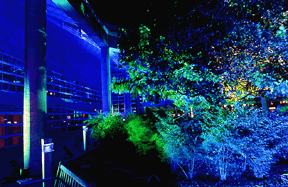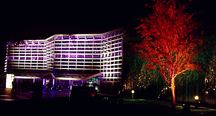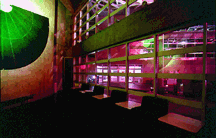| Articles:
Developing
students

Flipping the light fantastic
The Moudy
Building became its own work of art when lighting design students and faculty
used the atrium as a canvas for a spectacular living-color painting
By Nancy Bartosek

 At
8:55 p.m. on a dark but unseasonably balmy April evening, senior Emily
Choate shifted nervously among friends in front of the Moudy Building. At
8:55 p.m. on a dark but unseasonably balmy April evening, senior Emily
Choate shifted nervously among friends in front of the Moudy Building.
Dressed to impress, Choate knew all that
was left to do was watch the show. At promptly 9 p.m, she stopped mid-sentence
to dash off, proclaiming "Oh, it's starting."
Indeed, it was. An Easter-egg colored tree
had drawn a crowd, which together turned toward the luminescent building.
Now lit like the belly of the alien ship in Close Encounters of the Third
Kind, the brilliantly-hued atrium drew people en masse to the interior,
their necks craned upward.
Never had the Moudy Building been adorned
like this -- its odd angles and canopy of intersecting glass planes awash
in rich color, light and texture.
This is guerilla lighting at its best -- and
undergraduate lighting education unmatched in the world, said lighting
Prof. Fred Oberkircher. This radiant display capped the studies of 10
students earning a minor in lighting.
Two internationally known lighting designers
-- Paul Gregory of New York and Jonathan Speirs of Scotland -- gave their
time to design and then help the students set up the donated equipment,
which included more than 200 donated fixtures, a mile of cable and a 300-amp
generator truck, all at a combined value of $300,000.
 Even
with additional help by several professional lighting technicians, the
one-hour show took a week to set up. Even
with additional help by several professional lighting technicians, the
one-hour show took a week to set up.
"It's been such an adventure," Choate
said, her face aglow with reflected color. "It pulled together lots of
learning and knowledge that we had from class and put it to practical
application. "I sure never expected to be able to work with people like
Paul and Jonathan. It's been such an amazing experience."
Now in its fifth year, the TCU Center for
Lighting Education hosts a unique program that brings together elements
of retail, architectural and theatre lighting into a full undergraduate
minor.
 A
self-proclaimed "born-again lighting guy,"Oberkircher
said the program grew out of the department of Design, Merchandising and
Textiles 10 years ago during a University self-study. Faculty realized
the program needed a distinct centerpiece program to set it apart. Oberkircher
suggested that if they did anything in lighting, it would be a top-tier
program. A
self-proclaimed "born-again lighting guy,"Oberkircher
said the program grew out of the department of Design, Merchandising and
Textiles 10 years ago during a University self-study. Faculty realized
the program needed a distinct centerpiece program to set it apart. Oberkircher
suggested that if they did anything in lighting, it would be a top-tier
program.
Following a concerted re-education for
himself, Oberkircher, a registered architect, pulled together a couple
of courses in lighting that were already being taught and the minor was
born in 1997.
The TCU Center for Lighting Education now
glows with a national reputation and a $100,000 lab where students learn
the wares and watts of lighting. It draws professionals from around the
country, who receive training in the facility from major manufacturers.
It also supports research for various entities on and off campus, and
most important, provides a home for students learning how to light a stage,
a retail establishment, a home or a building.
Choate, a fashion promotion senior, said
her lighting minor was a major factor in landing a new job at a design
house in Dallas. In the field, the TCU center is well-known and respected,
but even companies unfamiliar with the program always raise their eyebrows
in interest at her minor.
On the night of the display, Gregory, president
of Focus Lighting in New York, beamed as visitors wandered through the
moving colors and shapes.
"By the end of the week, some of them
were doing work as good as what we see from some professional offices,"
he said. "Seeing that change was the best part of the week."
Oberkircher said the support they get from
industry attests to the need for this type of education.
"What we are is the right thing at the
right place at the right time; it's a good place to be."
Top
|



